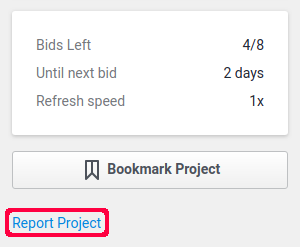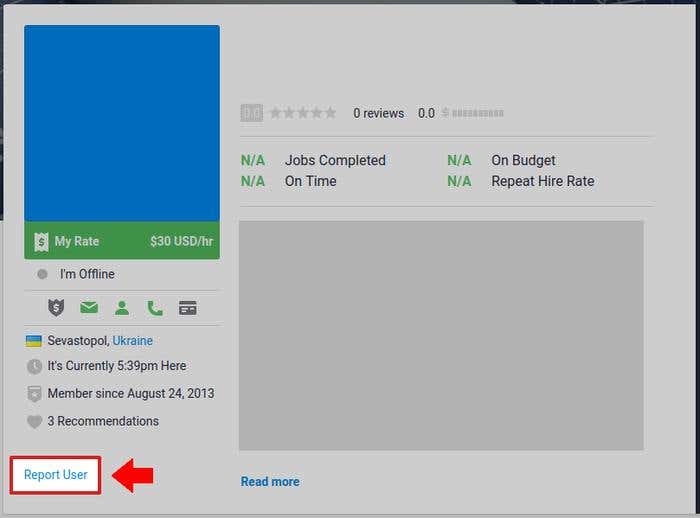Note: This advice is targeted at freelancers. Clients concerned about fraud should read our article on common freelancer scams and how to deal with them.
Finding a project and bidding for a client's work can be an exciting process. Yet occasionally a fraudulent client or scammer will post a project, causing trouble for clients on the platform.
The vast majority of these projects are automatically rejected by our spam algorithms or caught by our fraud teams, however sometimes a project will slip through the cracks.
As a freelancer, it is important that you are able to spot the red flags and early warning signs of these projects, and know the appropriate methods of reporting projects and clients that you think are spam.
#1: My client is asking me to send money to him/her offsite (directly via Paypal/Skrill/Bitcoin)
All transactions for a project or contest should be completed onsite via the freelancer platform. Never agree to send money to a client offsite whether it is via Paypal, Skrill or even Bitcoin. This often means that they are trying to pay via a stolen credit card that our anti-fraud teams will be unable to detect, leaving you at risk.
#2 My client is asking me to communicate with them off site (via Skype, WhatsApp or other methods)
Skype and Whatsapp are the common offsiting tools used by scammers. Avoid communicating to any client off the freelancer platform via Skype, WhatsApp or other methods. By communicating via the freelancer platform, you’ll have peace of mind in the case of a customer service complaint or payment dispute, that records of these conversations are checked by our customer service team.
If we do not have records of these conversations, we can only provide limited support or recommendations.
#3: My client is asking me for lots of free samples
Be wary if your client is asking for more than one or two samples of your work. Although it may be important to demonstrate your ability to a potential client, it’s easy to fall into the trap of giving away free work to scammers. Avoid agreeing to too many free samples - negotiate on a price and then have a Milestone Payment created for it.
#4: My client does not want to start a Milestone Payment until the project is complete
If your client refuses to start a Milestone Payment or avoids questions about their payment, then it may be best to think twice before accepting the project. Don’t fall into the trap of starting a project without an agreed upon Milestone Payment. Ensure that you’ve spoken to your client about their budget, how much you will be awarded at the completion of the project and have a Milestone Payment created for you.
#5: I’ve been asked to purchase special software from my client so that I can start on the project
Never start a project with a client if you have been asked to purchase particular software or equipment from them. All resources should be easily accessible to you without needing to pay for them. Be sure to clarify this with your client if he or she has asked you to purchase any equipment.
#6: My client is new to the platform and has no information on their profile
Before starting a project with a client, it’s important that you review their profile information for reviews, ratings and payment status. If your client is new to the platform and has no information to display, you should ask them to verify their payment method on their profile before starting a project.
#7: My client has received negative reviews
One of the most important things you should do before accepting a project is review their user profile and any reviews that they have been provided for previous projects. If the client is fairly new to the site or has received negative reviews, it most likely means trouble. Steer clear of clients that have received negative reviews and don’t be afraid to ask questions to new clients.
#8: My client is asking me for IDs and/other documents so they can “verify” my identity
Do not provide any form of ID or documentation to a client even if they are asking for it. Scammers are oftentimes successful when they have asked to “verify” an identity and are given access to ID and other documents. Avoid starting a project with a client if this is one of their prerequisites. Freelancer’s Know Your Customer (KYC) aims to prevent fraud and money laundering by confirming customer identity through documentation collection.
#9: My client gave me a link which requires me to sign in to a site with my personal details.
Be mindful if your client has asked you to access a link that requires you to enter your login details. Scammers often attempt to obtain sensitive information including usernames and passwords for malicious intent. Avoid a phishing attack by being proactive and aware of your client's behaviour.
#10: The project is invalid or rejected.
Projects that harm freelancers will be rejected and deemed ‘invalid’ by the platform. Some projects that violate Freelancer’s Terms and Conditions involve hacking, spamming, falsification of documents, creation, buying or selling of accounts. If a project is invalid or has been rejected, then it’s best not to work with the client. Check out our policy on invalid or rejected projects.
How do I report fraud or scams to Freelancer?
Support Page/Live Chat
If you suspect your client is attempting to scam you or you have noticed questionable behaviour, visit our support page and get in touch with one of our live chat support staff.
Report project
To report a project, simply open the project and click the 'Report Project' link located on the right side of the page, just below the 'Bookmark Project' button.

Report User
You can also report your client by visiting their profile page and clicking 'Report User.'

Be sure to take note of any of these warning signs before accepting a project or continuing with your client. Steer clear of any red flags and you’ll be well on your way to a hassle-free and successful project.